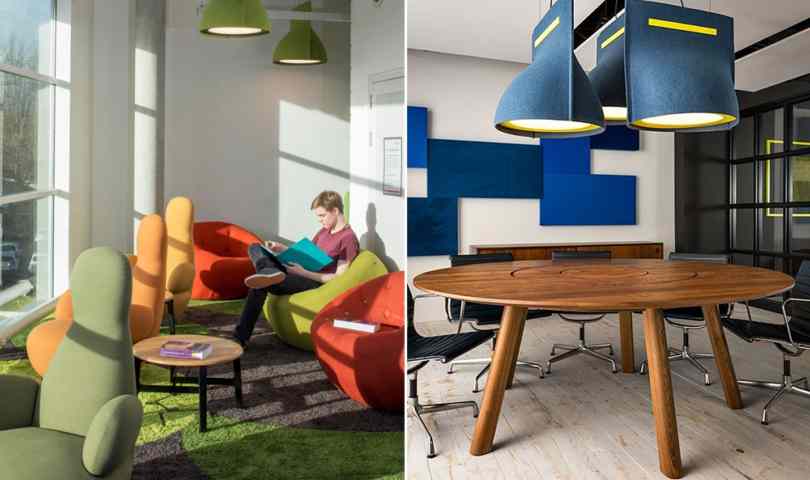Sponsored Content
Radius Office is one of Ireland’s leading premium office supplies companies. In this article, it explains why designing offices to minimise noise disruption is vital
With the growing number of open-plan offices springing up today in Ireland, it can often prove very difficult to stay focused on a given task due to the number of people working in one space. Employees operating in these types of offices are often subject to excessive noise and constant distractions.
However, open-plan offices have certainly encouraged interaction amongst colleagues, and with this, an exchange of new, creative ideas. This can indeed be viewed in a positive light. Yet, interruptions and loud noises, while unwelcome, are a real consequence of these spaces.
Office noises come in many forms, such as conversations between employees and those generated by the general hustle and bustle of any busy office. In fact, research shows that the biggest cause of lost productivity in an open workspace are ‘conversational distractions’.
This problem of excessive noise comes down to a poorly designed office, in which the room’s acoustics were not taken into account.
What are acoustics and how do they work?
Acoustics refers to the science of controlling noise in a given building, which consists of minimising noise transmission from one space to another – controlling the sound.
If a workspace is designed well, with acoustics in mind, it can have a big impact on how sound travels in the room and therefore it affects how noise is heard. Factors such as the size and height of the space, the average number of people and the type of walls in the room may determine the acoustic performance.
What are the effects of underperforming acoustics in a room?
There are several ways to know if a room has bad acoustics. The two most common giveaways are the space being too noisy and/or having an echo or reverberation.
When people are talking and the room becomes extremely noisy, you are not able to have a conversation. When talking to somebody, you might also hear the echo of the conversation. This means that the surface of the walls don’t have sound-absorbing properties and the sound bounces right back from them.
If you are experiencing one of the problems above, you need to think about treating your space with acoustics. Acoustic treatments do not include only panels but also lighting, screens and acoustic pods, which can be installed in a space to reduce the room’s noise levels. These treatments have sound-absorbing properties, as they are made from acoustic foam, which is a lightweight material.
Sound reduction vs soundproofing
Often, acoustic treatments are mistaken for acting as a method of soundproofing, meaning that no excess noise is heard at all. However they actually reduce excess noise as opposed to completely eradicate it.
It is not necessary to fully soundproof your meeting room or your open space area, but to simply reduce the sound heard from outside the room or around the space. When talking about sound reduction or sound absorption, you also need to know how reduction is required. A professional acoustic supplier will be able to estimate it, based on a noise reduction coefficient.
How is sound reduction performance measured?
The sound reduction performance of an acoustic panel is measured using the ‘Noise Reduction Coefficient’ (commonly abbreviated to NRC). This indicates how much sound is absorbed from the panel’s surface. Its coefficient ranges from 0.00 (total sound reflection) to 1 (total sound absorption). Depending on the room’s specification, the acoustics expert will calculate the best NRC and advise on the most suitable products to install in the room to improve acoustic performance.
Another way acoustic performance is classified is through an A to E classing system, which also includes the NRC range value. For instance, class A (best sound absorption) spans between a 0.9 and 1 NRC (meaning 90% to 100% of the sound is absorbed), while class E between ranges from a 0.15 – 0.25 NRC (which means only 15% to 25% of the sound is absorbed).
It is important to choose the right sound absorption class when you purchase office acoustics, in order to ensure effective sound reduction.
What types of acoustic treatments are available?
There are many different types of acoustic treatments available to suit every kind of space and requirement, both on the cheaper and more expensive ends of the cost bracket.
For example, acoustic lighting is quite a cost-effective option and serves a dual function of both lighting up a room as well as absorbing excess noise. Similarly, acoustic screens are more cost-friendly and serve multiple functions, as they act to also break up a space, which would suit larger open-plan offices with multiple workstations.
Both the lighting and screens are simple and easy to install. Acoustic panels are another option; they require installation, as they are often placed in striking patterns on walls to create a unique design. However, panels make a real impact and can be used to reflect a company’s branding.
Finally, for offices that have the budget and are in need of a quiet space for individual work and calls, the acoustic phone booths are the way forward. The phone booth can be placed in an open space and is an innovative and stylish solution to distraction-free work in a busy office.
What are the benefits of adding acoustics to an office space?
Increasing Productivity: The benefits of adding acoustics to your office are numerous. Firstly, the sound reduction properties that acoustic materials have mean there is less noise and with this, less distraction.
The opportunity to be able to work in a busy open office space with little to no noise disruptions is rare. Therefore, the calmer and quieter the environment is, the increased likelihood of being able to be more focused and thus improve performance at your work. With this, installing office acoustics can mean an increased productivity output.
Health and Wellbeing: Similarly, the higher productivity associated with calmer work environments can also be linked with an employee's health and wellbeing.
A less stressed office makes for less stressed workers, therefore positively impacting employees’ health and wellbeing. This is an extremely undervalued benefit of a quieter workspace, despite the fact that a tension-filled atmosphere seems to be all too common nowadays.
Style and Branding: The addition of acoustics such as panels, which come in a wide variety of shapes, colours and materials, not only serve a functional value but also an aesthetic one.
Although their primary role is sound reduction, panels act as a design focal point for any space they occupy. Whether it be company reception areas, open-office rooms or school canteens, they are bound to make an impact, one that can have huge implications for your company’s brand. They show you are trendy, stylish, and modern -- all of which go a long way in creating a forward-thinking business mindset.
Privacy: Certain acoustic products are hugely beneficial in creating privacy, which creates a sense of comfort for people who occupy the space. They feel like they can step away, whether to take a call or have a conversation with another employee, without being disturbed or interrupted.
This privacy is extremely valuable as companies continue to grow and spaces are being filled with more desks and chairs. Privacy can be created in the form of booths or pods, which can easily be placed in a busy work space. Acoustic screens are also useful and can be used to create privacy in between desk areas.
In conclusion, acoustics are often not considered until there seems to be an issue with the acoustic performance in a given space. Because of this, it is ideal to think about acoustics from the outset, at the design stage of an office or any other space.
Other factors can take precedence when designing a room, such as ensuring the space gets enough natural light, the overall layout, or the look and feel of the space.
Certain materials such as glass have been favoured for their clean, contemporary look but have poor sound absorption properties. However, this is where acoustic treatments can act as a valuable remedy. They also inject a much-needed splash of colour to a work office, and also make for a funky yet modern furnishing, leaving a lasting impression.









